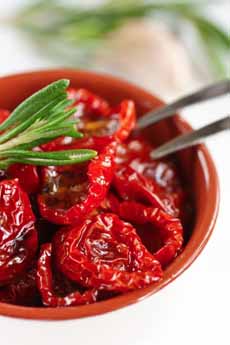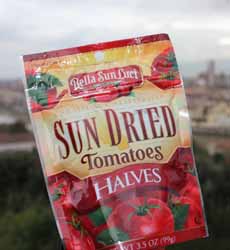RECIPE: Individual Spinach Soufflés With Sun-Dried Tomato
 [1] This spinach soufflé is made with sautéed whole spinach leaves (photo © Bella Sun Luci).
[4] Sealed bags keep give the sundried tomatoes a long shelf life (photo © Bella Sun Luci). |
July 16th is National Fresh Spinach Day. You can make your favorite spinach recipe (dip? salad?) or make these individual soufflés as first courses or sides. If you’ve only used frozen, chopped spinach in soufflés, this recipe delivers a more intense spinach flavor. Why use sundried tomatoes in summer, when there are fresh, local tomatoes to be had? Because the intensity of sundried tomatoes better complements the soufflé than the more subtle flavor of fresh tomatoes. You can substitute the sundried tomatoes with cherry tomatoes, if you like. Sundried tomatoes are a stock items in our pantry. You can use them at every meal: in omelets, with cottage cheese and yogurt, in green salads, as a garnish for proteins (marinated in olive oil), in a winter Caprese salad. You can also: We love the soft sweetness of the sealed packages from Bella Sun Luci. When we’ve purchased sundried tomatoes from an open bin, even though we place them in a sealed container, we find that within a week or two, they begin to lose their succulence and color. They’re on the road to turning brown, tough and dry. A factory-sealed package is better. This recipe will taste even better if you grate the parmesan freshly, from a wedge. Ingredients For 4 Souffles 1. PREHEAT a conventional oven (not convection) to 350°F. Heat the olive oil in sauté pan, and cook the garlic until it’s a light yellow color. Then add the spinach and a pinch of salt, and sauté until just cooked. 2. DRAIN off any liquid, remove to a bowl and set aside until it cools to room temperature. As the spinach cools, prepare the egg-cream mixture. Beat the eggs with 1 ounce heavy cream, 1 tablespoon grated parmesan, salt and freshly cracked black pepper to taste. 3. COMBINE the cool spinach with the egg-cream mixture; blend well. Grease the ramekins and sprinkle a pinch of flour onto the butter. Divide the soufflé mix among the ramekins. Top each with a sundried tomato. 4. PLACE the ramekins into a baking dish and add WARM water, so the water is 1/4 to 1/3 of the way up the side of the ramekins (i.e., a bain-marie or water bath). Bake 7-9 minutes, until the eggs puff up. 5. REMOVE from the oven, garnish each with a spinach leaf and serve hot. |
|
|
THE HISTORY OF SPINACH According to Mediterranean food expert Clifford A. White, spinach comes from a central and southwestern Asian gene center. It may have originated from Spinacia tetranda, which still grows wild in Anatolia. The plant, which does not like heat, was successfully cultivated in the hot and arid Mediterranean climate by Arab agronomists through the use of sophisticated irrigation techniques. The first known reference to spinach dates to between 226 and 640 C.E., in Persia. Over trade routes, spinach was introduced to India and then to ancient China in 647 C.E., where it was (and still is) called “Persian vegetable.” The first written reference to spinach in the Mediterranean are in three tenth-century texts. It became popular vegetable in Provence, and by the 15th century was common in Provençal gardens. It traveled north, and Europe became a spinach-loving continent. |
||





